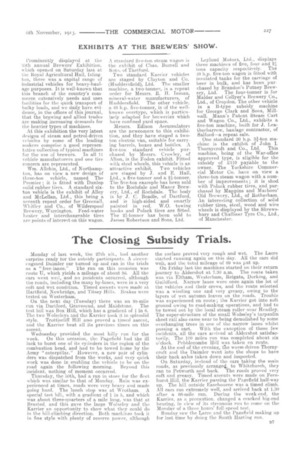The Closing Subsidy Trials.
Page 19

If you've noticed an error in this article please click here to report it so we can fix it.
Monday of last week, the 27th ult., had another surprise ready tor the subsidy participants. A sleeveengmed Daimler car turned up and ran in the trials as a, "free-lance." The run on this occasion was route U, which yields a mileage of about 96. All the cars went well, and no incidents occurred, although the roads, including the many by-lanes, were in a very soft and wet condition. Timed ascents were made at Hartfield, Newbridge, and Titsey Hills. Brakes were tested on Westerham.
On the next day (Tuesday) there was an 88-mile run via Dartford, Gravesend, and Maidstone. The test hill was Box Hill, which has a gradient of 1 in 6. The two Wolseleys and the K.arrier took it in splendid
style. Trottiseliff Hill also proved a timed ascent, and the Karrier beat all its previous times on this ascent.
Wednesday provided the most hilly run for the week. On this occasion, the Pagefield had the ill luck to burst one of its cylinders in the region of the combustion head, and had to be towed home by the Army " caterpillar.'' However, a new pair of cylinders was dispatched from the works, and very quick work was done in enabling the vehicle to be on the road again the following morning. Beyond this incident, nothing of moment occurred.
Thursday, the 30th, had a run in store for the fleet which was similar to that of Monday. Rain was experienced at times, roads were very heavy and made going hard. The lunch stop was at Wrotham. A special test hill, with a gradient of 1 in 5, and which was about three-quarters of a mile long, was that at Brasted, and this gave the large Wolseley and the Karrier an opportunity to show what they could do in the hill-climbing direction. Both machines took it in fine style with plenty of reserve power, although the surface proved very rough and wet. The La,cre started running again on this day. All the cars did well, and the total mileage of 89 was put up. On Friday last the machines started on their return journey to Aldershot at 7.30 a.m. The route taken was via Eltham, Westerharn, Reigate, Dorking, and Guildford. Narrow lanes were once again the lot of the vehicles and their crews, and the route selected was a winding one and very greasy, owing to the layers of wet autumn leaves on the roads. Trouble was experienced en route; the Karrier got into soft ground owing to road-making operations, and had to be towed out by the local steam roller near Headley. The super-structure of the small Wolseley's tarpaulin sheet-rail also came near to being demolished by some overhanging trees in one of the narrow lanes whilst passing a cart. With the exception of these few incidents, all the cars arrived at Aldershot satisfaotorily. The 100 miles run was completed about six o'clock. Pebblecombe Hill was taken en route.
At the end of the evening, the worm-driven Thornycroft and the Daimler went into the shops to have their back axles taken down and inspected.
On Saturday, instead of the cars taking the main roads, as previously arranged, to Whitchureh, they ran to Petworth and back The roads proved very soft and greasy. Timed ascents were made on. Fernhurst Hill, the Karrier passing the Pagefield half-way up. The hill outside Ea,sebourne was a timed climb. All ears ran extremely well, and arrived back at 1.30 after a 66-mile run. During the week-end, the Karrier, as a precaution. changed a cracked big-end bearing, in view of its strenuous run to come on the Monday of a three hours' full-speed test.
Sunday saw the Lacre and the Pagefield making up for lost time by doing the South Hartingrun.
























